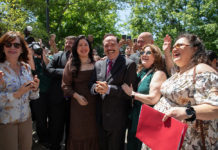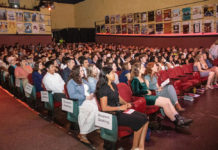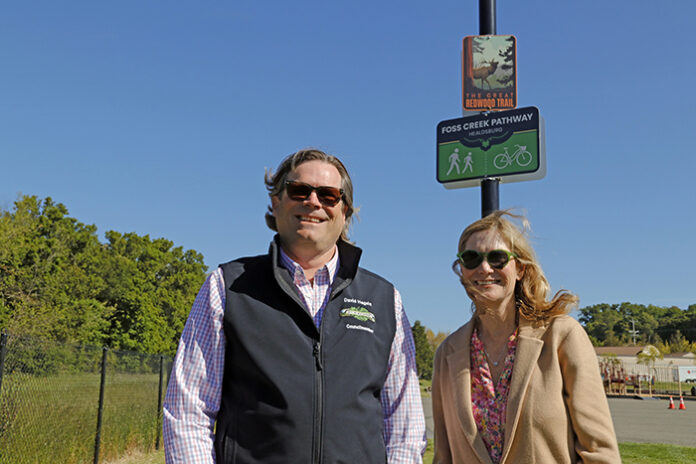
The board of directors of the Great Redwood Trail Agency (GRTA) held its bimonthly meeting in Healdsburg last Thursday, April 20, reviewing the current status of an ambitious plan to convert 316 miles of rail corridor into pedestrian and bike paths from the San Francisco Bay to Samoa, in Humboldt Bay.
They met just across the street from one of the first completed legs of the GRT itself, Healdsburg’s own Foss Creek Pathway.
“Healdsburg was in fact the impetus for the Great Redwood Trail,” said Sen. Mike McGuire, now majority leader of the state Senate, who has been the primary driver behind the Great Redwood Trail for almost 20 years.
From 2004 to 2010, McGuire was a city councilmember, and the youngest mayor in Healdsburg’s history at 26. “I remember sitting in the council chambers looking out from the windows seeing folks walk up and down the tracks,” recalled McGuire. He said the idea of opening up the Foss Creek corridor to let folks explore the town by means of the unused rail route had been gaining momentum at the time.
“The Foss Creek Trail really has changed the face for recreation in the city of Healdsburg, and it just made sense to build a walking path along Foss Creek. And then we started to think, why couldn’t we do that through the North Coast?” McGuire said.
Trail advocates for decades had talked about building a version of the Great Redwood Trail, but the moribund North Coast Rail Authority (NCRA) stood in the way. It took a change in state law, championed by McGuire when he became a state senator in 2014, to eventually replace the NCRA with the Great Redwood Trail Agency—a change that was finally accomplished in 2021.
The nine-member GRTA board is currently chaired by Caryl Hart, a former director of Sonoma Regional Parks. Among its members are Healdsburg City Council member David Hagele, and others from local governments from Marin County to the Oregon border, including county supervisors from Trinity and Mendocino.
Meeting in City Council Chambers last week, the GRTA board heard updates on the state of the Master Plan process currently underway, with recent workshops in Fortuna and Willits. Its goal is a spring 2024 release of a draft master plan, described as a “high-level roadmap” to guide trail design, maintenance and operations, habitat restoration and other project priorities.
Railbanking
The Great Redwood Trail builds on what’s called “railbanking” to enable disused rail corridors to be “banked” for future use through interim use as trails. The national Rails-to-Trails Conservancy has advocated railbanking for 40 years.
“Railbanking is a very simple concept that a railroad right of way is still a valuable asset, even if there’s no railroad using it,” said Peter Raynor, the central author of the 1983 Railbanking Act. Since rail corridors have already been federally designated for transportation use, it was Raynor’s insight that defining transportation to include hiking and biking would enable the railroad easements to be used for public trails.
The trails keep the rail right-of-way intact, as if “banked.” If a rail company makes a good case that they need the rail line back, it will be returned to rail and removed from the trail system.
“Since the mid-1980s, out of the 25,000 miles of rail that’s been transitioned to trail, less than 100 miles of trail have been removed,” said McGuire.
The Great Redwood Trail would include significant railbanked sections, as a state law has already railbanked the route from Willits north. The southern end, from Willits to the Sonoma County line, has not yet been recategorized by the Surface Transportation Board, but McGuire and others are optimistic.
“We’re hopeful that we’re going to have a successful outcome at the [board]. There has not been a large freight operator that has operated from Willits to the Mendocino-Sonoma County line in over 30 years,” said McGuire. “And there’s a reason for that. There is not a viable business operation. If there was a viable business operation, we would’ve seen a freight operator operating in perpetuity.”
As far as an economically viable vision for the route, McGuire is characteristically bullish. “The Great Redwood Trail is going to be one of the largest economic development projects that the North Coast has seen. There are very few projects that can generate nearly 62 million in new spending for communities. The Great River Trail can do that,” he said.
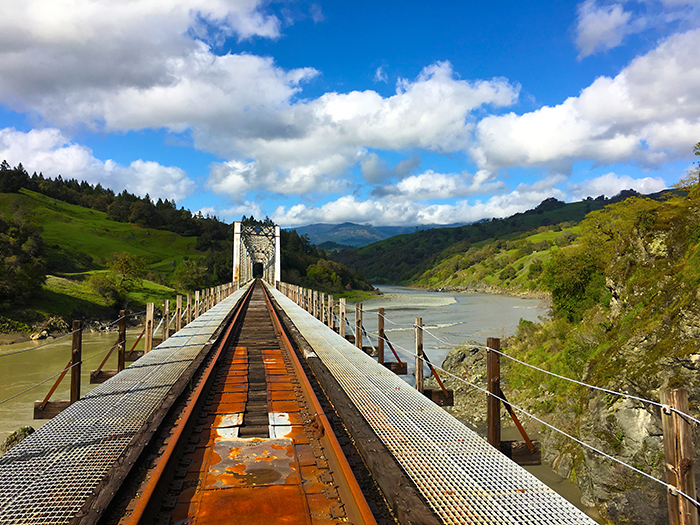
Master Plan
The completed Great Redwood Trail would adapt to its landscape—from single-track backcountry trail, to crushed stone multi-use trails, to paved multi-use trails in high-usage areas.
The route is expected to include scenic landscapes such as old growth redwood forests, oak woodlands, vineyards and wineries, scenic rivers including the Russian and the Eel, state parks and Humboldt Bay.
Though the public GRT workshops earlier this month were lively and well attended, they were not cheerleading events. Among the positives mentioned that the GRT might bring were overnight lodging for users of the trail, restaurants, river access, camping facilities and other local hospitality businesses. Equestrian use also generated considerable interest.
But there was a strong element of private property concern as well, specifically about trespassing, trash and sanitation, poaching, unwanted camping and fire risk, and the responsibility for enforcement that would go along with such trail abuse.
At this stage of its development, the Great Redwood Trail is focused on gathering information and community buy-in. Additional outreach will continue into February 2024, to include developed conceptual designs for key trial segments.
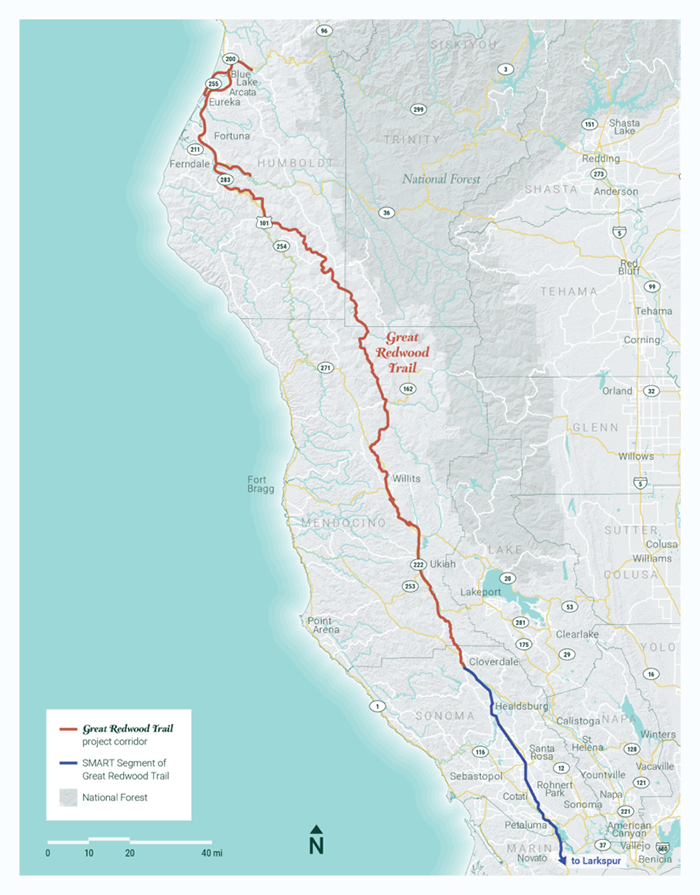
SMART Pathways
While the Master Plan development timeline continues with community events and workshops from Hopland to Eureka, there are no such public events planned for Marin or Sonoma County cities. The nearest opportunity for local engagement is a July 27 workshop in Hopland.
The reason is that the Great Redwood Trail incorporates the SMART Pathway system that will create pedestrian and bike trails running parallel or in conjunction with the commuter rail line.
SB1029, which created the Great Redwood Trail in 2018, formalized the relationship of the SMART Pathway to the Great Redwood Trail, according to Julia Gonzalez, SMART’s communications and marketing manager.
“The SMART Multiuse Pathway system is the pedestrian/bicycle adjunct to the SMART passenger rail system,” said Gonzalez. “Both the railway and pathway are part of the SMART District and are financed and developed by the SMART District.”
It was perhaps appropriate that one of the first finished elements of the complete trail, envisioned to run from Larkspur to Samoa, is the Foss Creek Pathway in Healdsburg, now part of both the SMART Pathways and the Great Redwood Trail. To date, it has cost over $3.24 million, though more than half of that has come from the county’s Measure M funds.
“There has been no funding from SMART or the GRT,” said Healdsburg’s public works director Larry Zimmer. “Basically the city built this for the our residents and visitors, but it will become an important piece for the region as the SMART Multiuse Path and the GRT connect to it.”
The alliance with SMART and local communities’ own projects will permit the Great Redwood Trail, when complete, to make possible over 300 miles of non-polluting human-powered travel from the Bay Area through the Emerald Triangle, or smaller walks or rides along parts of it.
The Great Redwood Trail Agency “is now charged to build out the longest rail trail in the United States,” said McGuire. “You can’t beat it. And we’re really excited that the momentum is on our side.”
An online workshop of the April 4 Great Redwood Trail Master Plan meeting is available by video on the Events web page at greatredwoodtrailplan.org.




